Assessment of Sustainable Development Suitability in Linear Cultural Heritage—A Case of Beijing Great Wall Cultural Belt
Abstract
:1. Introduction
2. Literature Review
2.1. Status of Sustainable Development Research Regarding Linear Cultural Heritage
2.2. Sustainable Development Suitability of Linear Cultural Heritage
2.3. Method for Determining LCH Sustainable Development Suitability
3. Materials and Methods
3.1. Study Area
3.2. Data Source
3.3. Assessing Indicators of Sustainable Development Suitability
3.3.1. Establishment of the Index System
3.3.2. Determining the Weight of Each Criterion via AHP Techniques
- 1.
- Decomposing a decision issue and building a hierarchical model of criteria and decision alternatives;
- 2.
- Pairwise comparison between criteria and vectorization of weights;
- 3.
- Pairwise comparison between decision alternatives on each criterion and the production of local weight vectors;
- 4.
3.3.3. Calculating the Sustainable Development Suitability Index
3.4. Development Suitability Type Assessment of the Valley Units
3.5. Spatial Autocorrelation Analysis Used to Assess Development Suitability
4. Results and Discussion
4.1. Distribution of Sustainable Development Suitability in the Beijing Great Wall Cultural Belt
4.2. Zoning of Development Suitability Types in Beijing Great Wall Cultural Belt
4.3. Spatial Characteristics of Sustainable Development Suitability in Beijing Great Wall Cultural Belt
5. Conclusions
- 1.
- There is a discernible polarization in terms of the level of suitability for sustainable development. The distribution of ecological suitability is low in the west and high in the east. In contrast, high cultural and socio-economic suitability values are distributed in a point pattern and exhibit a synergistic phenomenon.
- 2.
- Along the Beijing Great Wall Cultural Belt, the valley units have development suitability patterns. Most valleys have single or multiple ecological advantages, and the ecological suitability and carrying capacity along the Great Wall are high.
- 3.
- The spatial autocorrelation analysis reveals seven clusters in the valley area: Badaling Cluster, Huanghuacheng Cluster, Gubeikou Cluster, and Malanyu Cluster as heated spots; Yanhecheng Cluster, Hegukguan Cluster, and Baihedao Cluster as cold spots. Sustainable development should rely on clusters with exceptional advantages to motivate the surrounding areas to synergistically develop and prevent the overdevelopment of individual clusters to achieve more efficient outcomes.
Author Contributions
Funding
Data Availability Statement
Acknowledgments
Conflicts of Interest
Appendix A
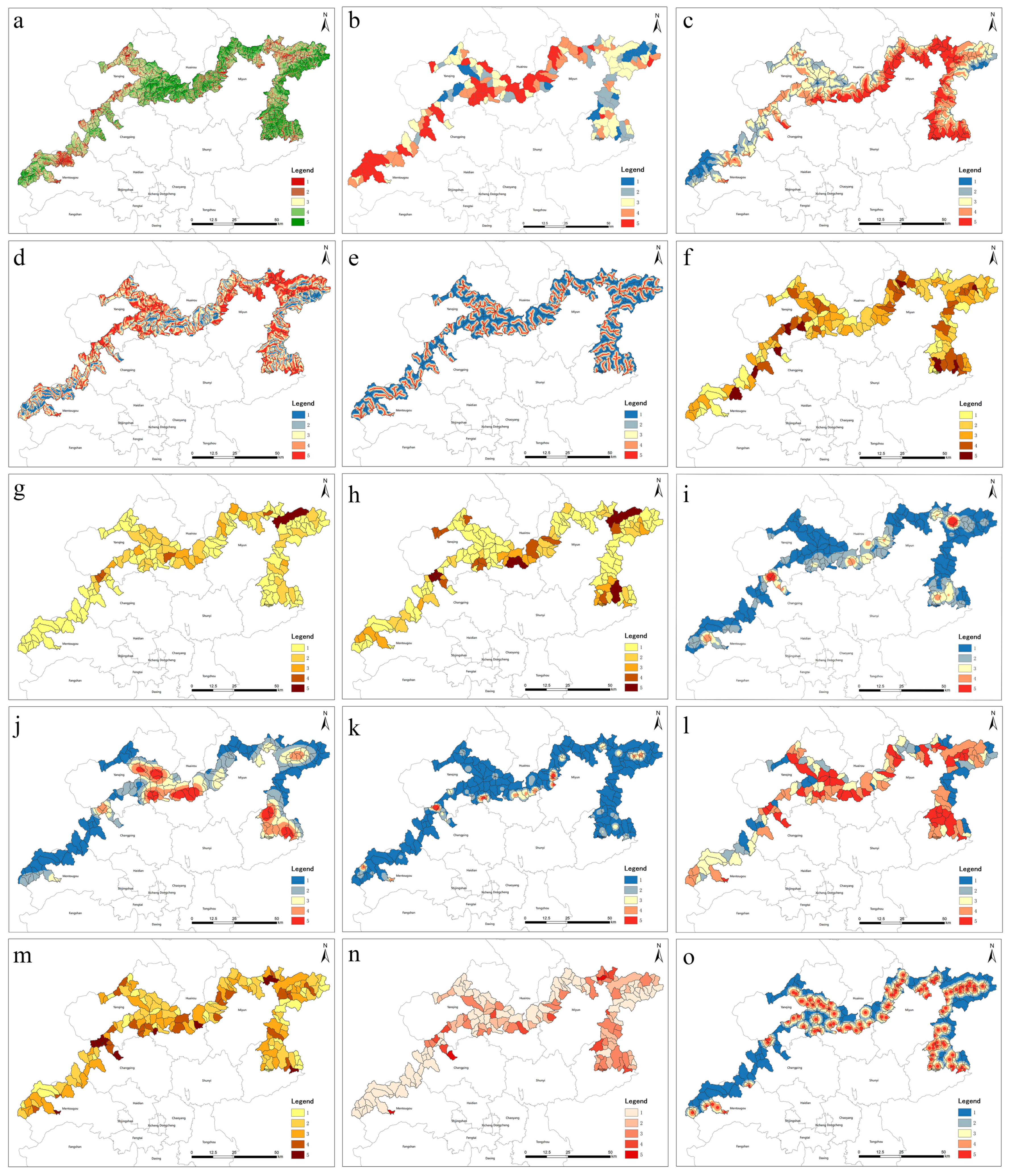
References
- Wu, Z.; Ma, J.; Zhang, H. Spatial Reconstruction and Cultural Practice of Linear Cultural Heritage: A Case Study of Meiguan Historical Trail, Guangdong, China. Buildings 2022, 13, 105. [Google Scholar]
- Oikonomopoulou, E.; Delegou, E.T.; Sayas, J.; Moropoulou, A. An innovative approach to the protection of cultural heritage: The case of cultural routes in Chios Island, Greece. J. Archaeol. Sci. Rep. 2017, 14, 742–757. [Google Scholar]
- Chen, Y.; Dang, A.; Peng, X. Building a cultural heritage corridor based on geodesign theory and methodology. J. Urban Manag. 2014, 3, 97–112. [Google Scholar]
- Li, H.; Jing, J.; Fan, H.; Li, Y.; Liu, Y.; Ren, J. Identifying cultural heritage corridors for preservation through multidimensional network connectivity analysis—A case study of the ancient Tea-Horse Road in Simao, China. Landsc. Res. 2021, 46, 96–115. [Google Scholar]
- Zhang, S.; Liu, J.; Pei, T.; Chan, C.-S.; Wang, M.; Meng, B. Tourism value assessment of linear cultural heritage: The case of the Beijing–Hangzhou Grand Canal in China. Curr. Issues Tour. 2023, 26, 47–69. [Google Scholar]
- Jiang, P.; Shao, L.; Baas, C. Interpretation of value advantage and sustainable tourism development for railway heritage in China Based on the analytic hierarchy process. Sustainability 2019, 11, 6492. [Google Scholar]
- Li, L.; Feng, R.; Xi, J. Ecological risk assessment and protection zone identification for linear cultural heritage: A case study of the Ming Great Wall. Int. J. Environ. Res. Public Health 2021, 18, 11605. [Google Scholar] [PubMed]
- Vecco, M.; Srakar, A. The unbearable sustainability of cultural heritage: An attempt to create an index of cultural heritage sustainability in conflict and war regions. J. Cult. Herit. 2018, 33, 293–302. [Google Scholar]
- Bamrungkhul, S.; Tanaka, T. The assessment of land suitability for urban development in the anticipated rapid urbanization area from the Belt and Road Initiative: A case study of Nong Khai City, Thailand. Sustain. Cities Soc. 2022, 83, 103988. [Google Scholar]
- Akbari, M.; Neamatollahi, E.; Neamatollahi, P. Evaluating land suitability for spatial planning in arid regions of eastern Iran using fuzzy logic and multi-criteria analysis. Ecol. Indic. 2019, 98, 587–598. [Google Scholar]
- Boley, B.B.; Johnson Gaither, C. Exploring empowerment within the Gullah Geechee cultural heritage corridor: Implications for heritage tourism development in the Lowcountry. J. Herit. Tour. 2016, 11, 155–176. [Google Scholar]
- Zheng, D.; Liang, Z.; Ritchie, B.W. Residents’ social dilemma in sustainable heritage tourism: The role of social emotion, efficacy beliefs and temporal concerns. J. Sustain. Tour. 2020, 28, 1782–1804. [Google Scholar]
- Ristić, D.; Vukoičić, D.; Nikolić, M.; Božović, S.; Milinčić, M. Tourism value assessment model of ‘UNESCO-listed’monasteries: Kosovo and Metohija. Curr. Issues Tour. 2020, 23, 2098–2102. [Google Scholar]
- Yang, J.; You, Y.; Ye, X.; Lin, J. Cultural heritage sites risk assessment based on RS and GIS—Takes the Fortified Manors of Yongtai as an example. Int. J. Disaster Risk Reduct. 2023, 88, 103593. [Google Scholar]
- Calgaro, E.; Lloyd, K.; Dominey-Howes, D. From vulnerability to transformation: A framework for assessing the vulnerability and resilience of tourism destinations. J. Sustain. Tour. 2014, 22, 341–360. [Google Scholar]
- Hu, H.; Qiao, X.; Yang, Y.; Zhang, L. Developing a resilience evaluation index for cultural heritage site: Case study of Jiangwan Town in China. Asia Pac. J. Tour. Res. 2021, 26, 15–29. [Google Scholar]
- Niu, S.; Lau, S.S.Y.; Shen, Z.; Lau, S.S.Y. Sustainability issues in the industrial heritage adaptive reuse: Rethinking culture-led urban regeneration through Chinese case studies. J. Hous. Built Environ. 2018, 33, 501–518. [Google Scholar]
- Cucco, P.; Maselli, G.; Nesticò, A.; Ribera, F. An evaluation model for adaptive reuse of cultural heritage in accordance with 2030 SDGs and European Quality Principles. J. Cult. Herit. 2023, 59, 202–216. [Google Scholar]
- Ost, C. Inclusive economic development in the urban heritage context. In World Heritage and Sustainable Development; Routledge: London, UK, 2018; pp. 53–67. [Google Scholar]
- Nicu, I.C. Cultural heritage assessment and vulnerability using Analytic Hierarchy Process and Geographic Information Systems (Valea Oii catchment, North-eastern Romania). An approach to historical maps. Int. J. Disaster Risk Reduct. 2016, 20, 103–111. [Google Scholar]
- Božić, S.; Tomić, N. Developing the Cultural Route Evaluation Model (CREM) and its application on the Trail of Roman Emperors, Serbia. Tour. Manag. Perspect. 2016, 17, 26–35. [Google Scholar] [CrossRef]
- Ferretti, V.; Comino, E. An integrated framework to assess complex cultural and natural heritage systems with Multi-Attribute Value Theory. J. Cult. Herit. 2015, 16, 688–697. [Google Scholar] [CrossRef]
- Li, F.; Zou, T. National Culture Park: Logical, origins and implications. Tour. Trib 2021, 36, 14–26. [Google Scholar]
- Mei, Y.; Yao, X.; Liu, X. Analysis on the Cognition of National Culture Park from the Perspective of Cultural Value: Reflections Based on the Practice of the Grand Canal National Culture Park. Mod. Urban Res. 2021, 7, 7–11. [Google Scholar]
- Kazemi, F.; Hosseinpour, N. GIS-based land-use suitability analysis for urban agriculture development based on pollution distributions. Land Use Policy 2022, 123, 106426. [Google Scholar] [CrossRef]
- Jayasooria, D. Sustainable development goals and social work: Opportunities and challenges for social work practice in Malaysia. J. Hum. Rights Soc. Work 2016, 1, 19–29. [Google Scholar] [CrossRef]
- Bassily, V.; Abufarag, T.; Goubran, S. Heritage Buildings’ Façades as Facilitators for Local Sustainable Development: The Case of Cairo’s El Korba Area. Heritage 2022, 5, 2689–2731. [Google Scholar] [CrossRef]
- Naheed, S.; Shooshtarian, S. The role of cultural heritage in promoting urban sustainability: A brief review. Land 2022, 11, 1508. [Google Scholar] [CrossRef]
- Guzman, P. Assessing the sustainable development of the historic urban landscape through local indicators. Lessons from a Mexican World Heritage City. J. Cult. Herit. 2020, 46, 320–327. [Google Scholar] [CrossRef]
- Della Spina, L. Adaptive sustainable reuse for cultural heritage: A multiple criteria decision aiding approach supporting urban development processes. Sustainability 2020, 12, 1363. [Google Scholar] [CrossRef]
- Lazar, N.; Chithra, K. A comprehensive literature review on development of Building Sustainability Assessment Systems. J. Build. Eng. 2020, 32, 101450. [Google Scholar] [CrossRef]
- Ma, H.; Li, S.; Chan, C.-S. Analytic Hierarchy Process (AHP)-based assessment of the value of non-World Heritage Tulou: A case study of Pinghe County, Fujian Province. Tour. Manag. Perspect. 2018, 26, 67–77. [Google Scholar] [CrossRef]
- Saaty, T.L. Decision making with the analytic hierarchy process. Int. J. Serv. Sci. 2008, 1, 83–98. [Google Scholar] [CrossRef]
- Awad, J.; Jung, C. Extracting the planning elements for sustainable urban regeneration in Dubai with AHP (analytic hierarchy process). Sustain. Cities Soc. 2022, 76, 103496. [Google Scholar] [CrossRef]
- Kittipongvises, S.; Phetrak, A.; Rattanapun, P.; Brundiers, K.; Buizer, J.L.; Melnick, R. AHP-GIS analysis for flood hazard assessment of the communities nearby the world heritage site on Ayutthaya Island, Thailand. Int. J. Disaster Risk Reduct. 2020, 48, 101612. [Google Scholar] [CrossRef]
- Zabihi, H.; Alizadeh, M.; Wolf, I.D.; Karami, M.; Ahmad, A.; Salamian, H. A GIS-based fuzzy-analytic hierarchy process (F-AHP) for ecotourism suitability decision making: A case study of Babol in Iran. Tour. Manag. Perspect. 2020, 36, 100726. [Google Scholar] [CrossRef]
- Peng, J.; Liu, Z.; Liu, Y.; Hu, X.; Wang, A. Multifunctionality assessment of urban agriculture in Beijing City, China. Sci. Total Environ. 2015, 537, 343–351. [Google Scholar] [CrossRef]
- Foroozesh, F.; Monavari, S.M.; Salmanmahiny, A.; Robati, M.; Rahimi, R. Assessment of sustainable urban development based on a hybrid decision-making approach: Group fuzzy BWM, AHP, and TOPSIS–GIS. Sustain. Cities Soc. 2022, 76, 103402. [Google Scholar] [CrossRef]
- Pinero, I.; San-Jose, J.T.; Rodriguez, P.; Losanez, M.M. Multi-criteria decision-making for grading the rehabilitation of heritage sites. Application in the historic center of La Habana. J. Cult. Herit. 2017, 26, 144–152. [Google Scholar] [CrossRef]
- Nadkarni, R.R.; Puthuvayi, B. A comprehensive literature review of Multi-Criteria Decision Making methods in heritage buildings. J. Build. Eng. 2020, 32, 101814. [Google Scholar] [CrossRef]
- Du, Y.; Chen, W.; Cui, K.; Zhang, K. Study on damage assessment of earthen sites of the Ming Great Wall in Qinghai Province based on Fuzzy-AHP and AHP-TOPSIS. Int. J. Archit. Herit. 2019, 14, 903–916. [Google Scholar] [CrossRef]
- Liu, C.; Liu, P. Probe into protecting and developing ancient villages while constructing valley economy in the mountainous areas of Beijing. Econ. Geogr. 2011, 31, 1923–1929. [Google Scholar]
- Shi, K.; Chang, Z.; Chen, Z.; Wu, J.; Yu, B. Identifying and evaluating poverty using multisource remote sensing and point of interest (POI) data: A case study of Chongqing, China. J. Clean. Prod. 2020, 255, 120245. [Google Scholar] [CrossRef]
- Huang, Y.; Shen, S.; Hu, W.; Li, Y.; Li, G. Construction of Cultural Heritage Tourism Corridor for the Dissemination of Historical Culture: A Case Study of Typical Mountainous Multi-Ethnic Area in China. Land 2022, 12, 138. [Google Scholar] [CrossRef]
- He, X.; Bo, Y.; Du, J.; Li, K.; Wang, H.; Zhao, Z. Landscape pattern analysis based on GIS technology and index analysis. Clust. Comput. 2019, 22, 5749–5762. [Google Scholar] [CrossRef]
- Božić, S.; Berić, D. Tourist Valorization of Cultural Route “The Trail of the Roman Emperors”. Eur. Res. 2013, 55, 1902–1913. [Google Scholar] [CrossRef]
- Moroke, T.; Schoeman, C.; Schoeman, I. Developing a neighbourhood sustainability assessment model: An approach to sustainable urban development. Sustain. Cities Soc. 2019, 48, 101433. [Google Scholar] [CrossRef]
- De Oliveira Cavalcanti, C.; Limont, M.; Dziedzic, M.; Fernandes, V. Sustainability assessment methodology of urban mobility projects. Land Use Policy 2017, 60, 334–342. [Google Scholar] [CrossRef]
- Saaty, T.L.; Vargas, L.G.; Saaty, T.L.; Vargas, L.G. The seven pillars of the analytic hierarchy process. In Models, Methods, Concepts & Applications of the Analytic Hierarchy Process; Springer: Berlin/Heidelberg, Germany, 2012; pp. 23–40. [Google Scholar]
- Morandi, D.T.; de Jesus França, L.C.; Menezes, E.S.; Machado, E.L.M.; da Silva, M.D.; Mucida, D.P. Delimitation of ecological corridors between conservation units in the Brazilian Cerrado using a GIS and AHP approach. Ecol. Indic. 2020, 115, 106440. [Google Scholar] [CrossRef]
- Pérez-Rodríguez, F.; Rojo-Alboreca, A. The triangle assessment method: A new procedure for eliciting expert judgement. Expert Syst. Appl. 2017, 72, 139–150. [Google Scholar] [CrossRef]
- Xu, F.-L.; Zhao, S.-S.; Dawson, R.W.; Hao, J.-Y.; Zhang, Y.; Tao, S. A triangle model for evaluating the sustainability status and trends of economic development. Ecol. Model. 2006, 195, 327–337. [Google Scholar] [CrossRef]
- Anselin, L.; Bera, A.K. Introduction to spatial econometrics. In Handbook of Applied Economic Statistics; CRC Press: Boca Raton, FL, USA, 1998; p. 237. [Google Scholar]
- Hu, X.; Ma, C.; Huang, P.; Guo, X. Ecological vulnerability assessment based on AHP-PSR method and analysis of its single parameter sensitivity and spatial autocorrelation for ecological protection–A case of Weifang City, China. Ecol. Indic. 2021, 125, 107464. [Google Scholar] [CrossRef]
- Yao, X.; Zeng, J.; Li, W. Spatial correlation characteristics of urbanization and land ecosystem service value in Wuhan Urban Agglomeration. Trans. Chin. Soc. Agric. Eng. 2015, 31, 249–256. [Google Scholar]
- Li, J.; He, J.; Liu, Y.; Wang, D.; Rafay, L.; Chen, C.; Hong, T.; Fan, H.; Lin, Y. Spatial autocorrelation analysis of multi-scale damaged vegetation in the Wenchuan earthquake-affected area, Southwest China. Forests 2019, 10, 195. [Google Scholar] [CrossRef]
- He, J.; Pan, Z.; Liu, D.; Guo, X. Exploring the regional differences of ecosystem health and its driving factors in China. Sci. Total Environ. 2019, 673, 553–564. [Google Scholar] [CrossRef]
- Wu, Z.; Zhang, F.; Di, D.; Wang, H. Study of spatial distribution characteristics of river eco-environmental values based on emergy-GeoDa method. Sci. Total Environ. 2022, 802, 149679. [Google Scholar] [CrossRef]
- Yang, Z.; Hao, P.; Cai, J. Economic clusters: A bridge between economic and spatial policies in the case of Beijing. Cities 2015, 42, 171–185. [Google Scholar] [CrossRef]
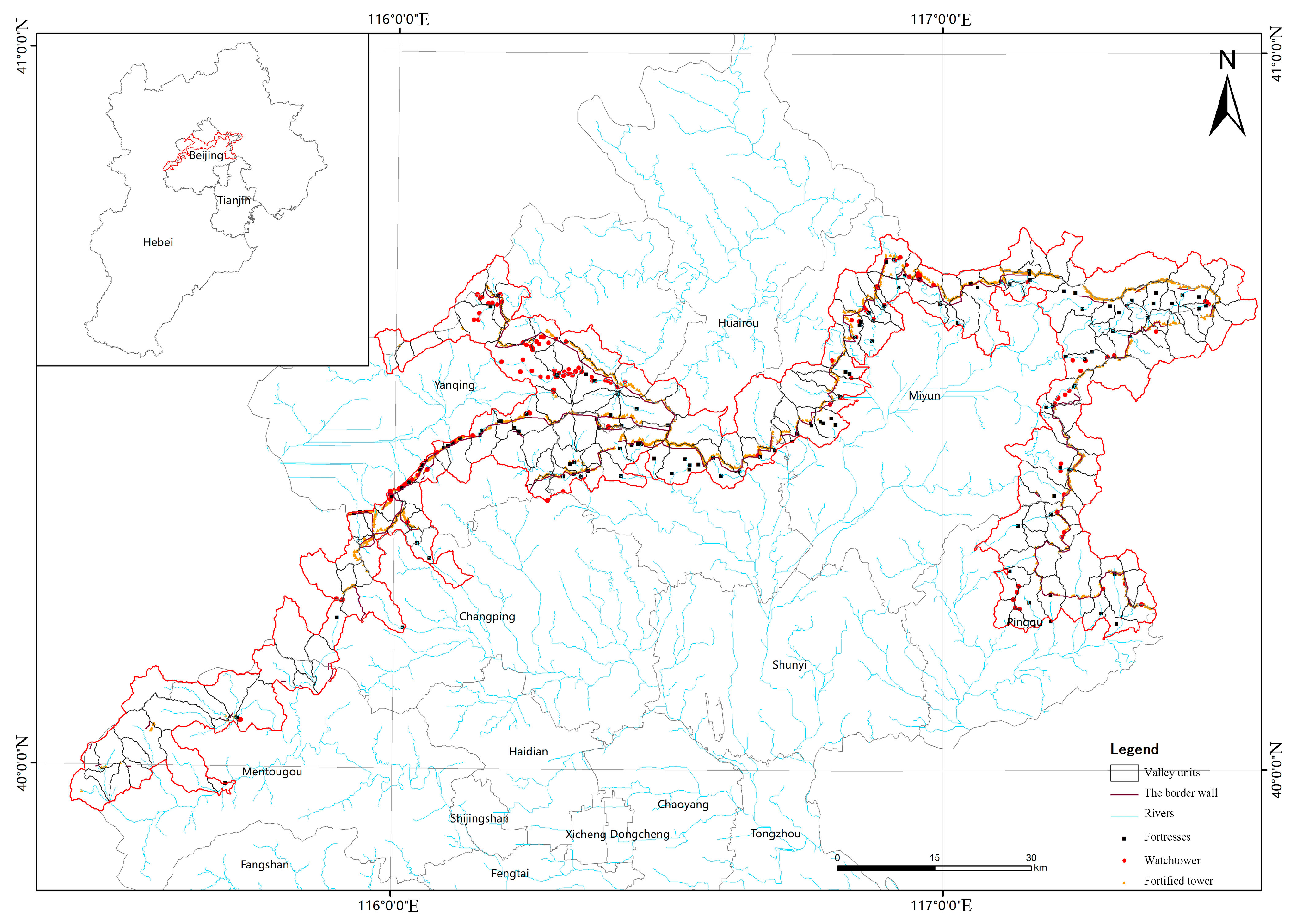
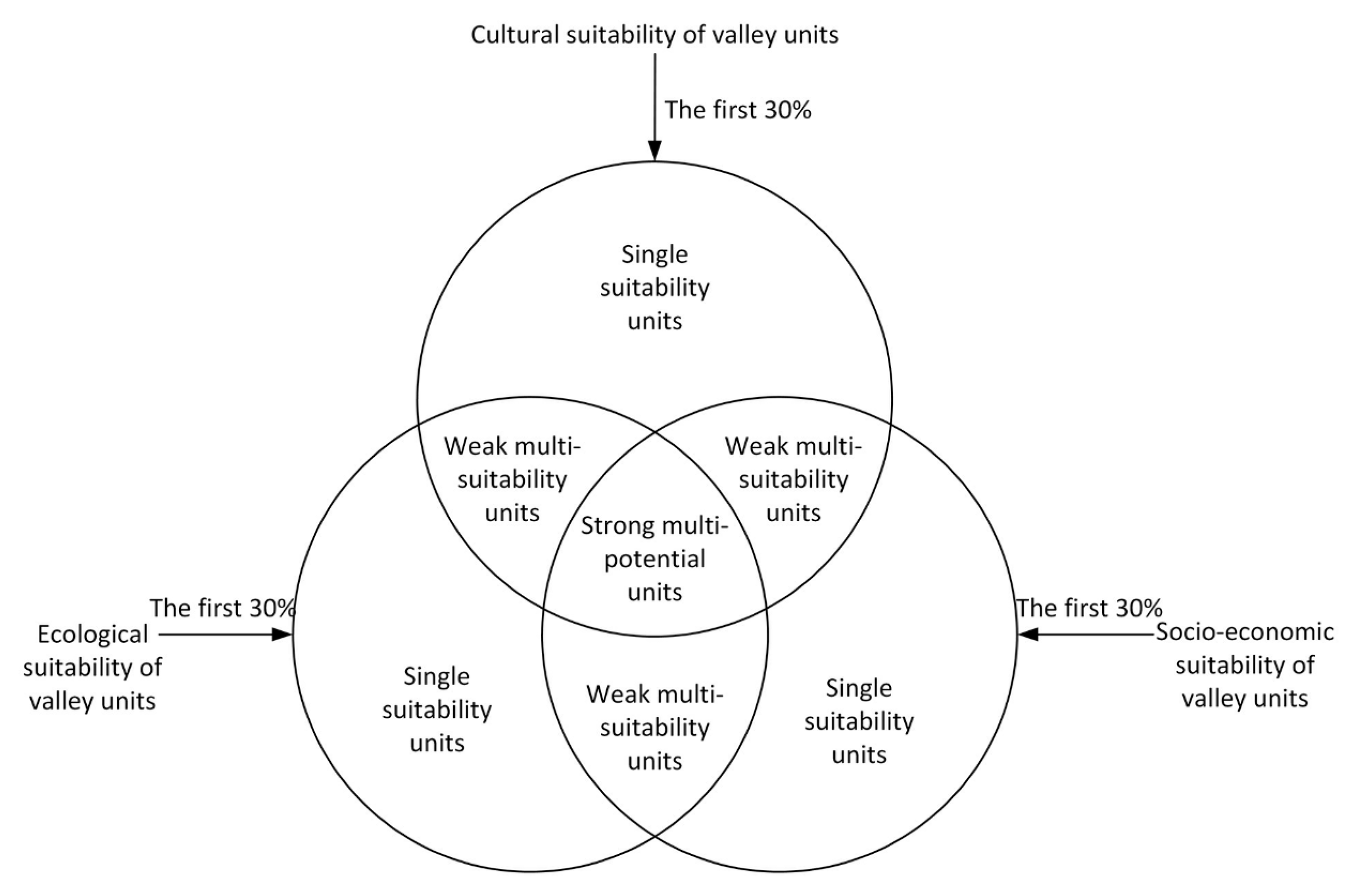
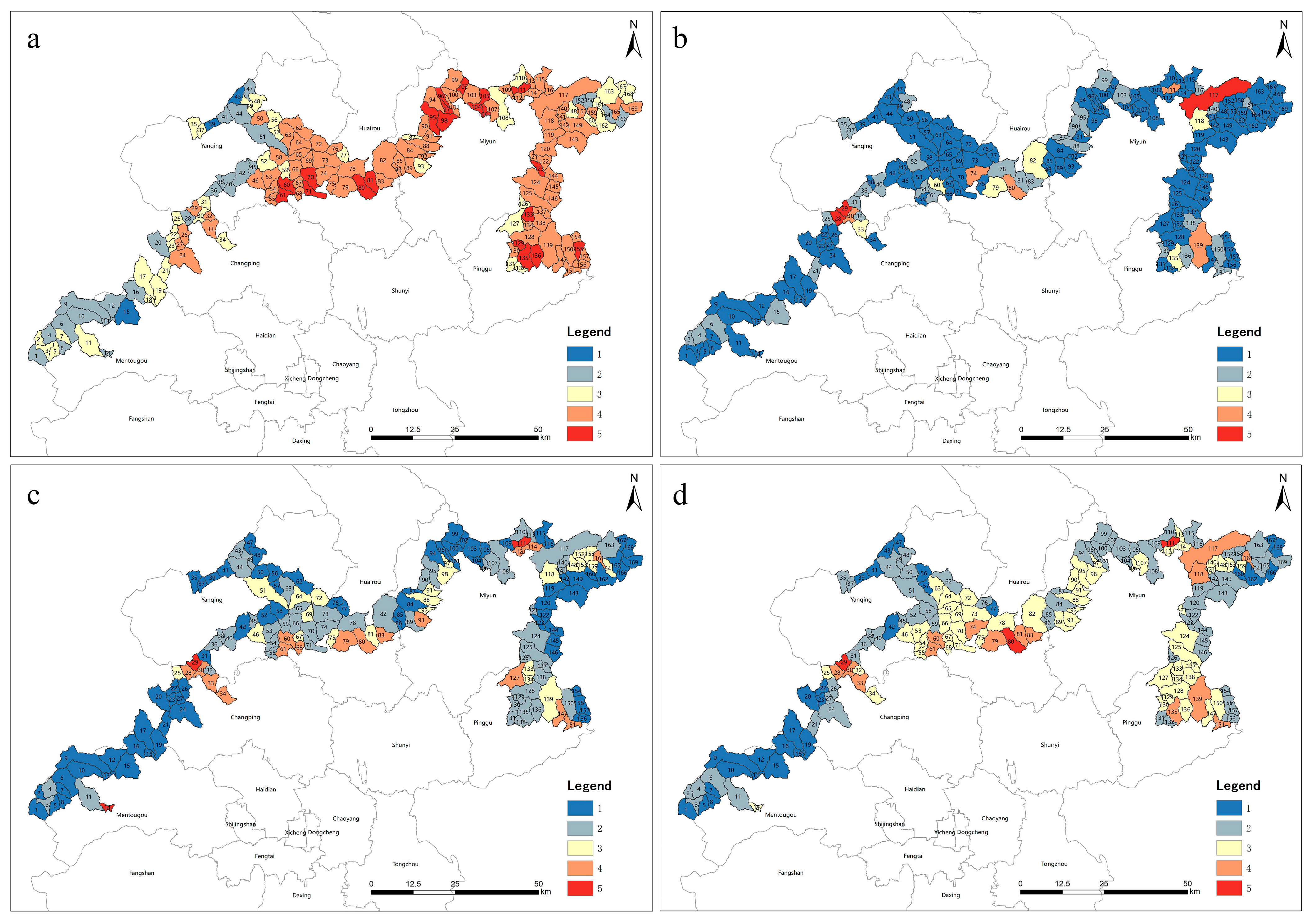
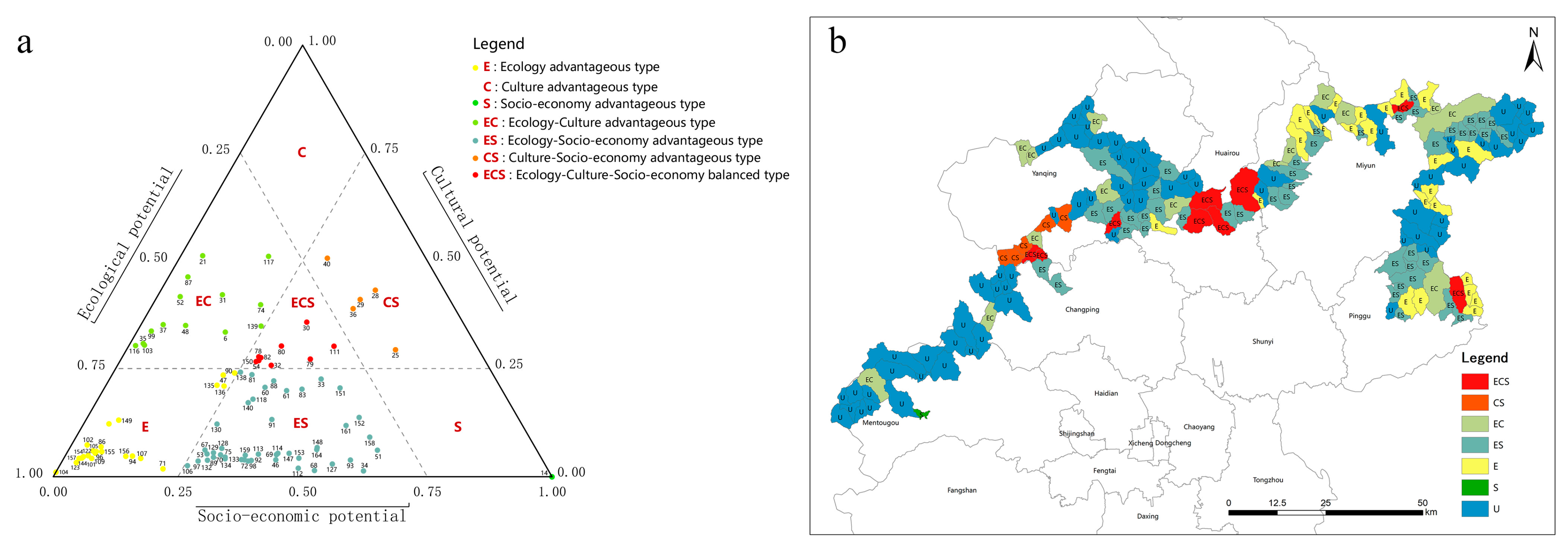
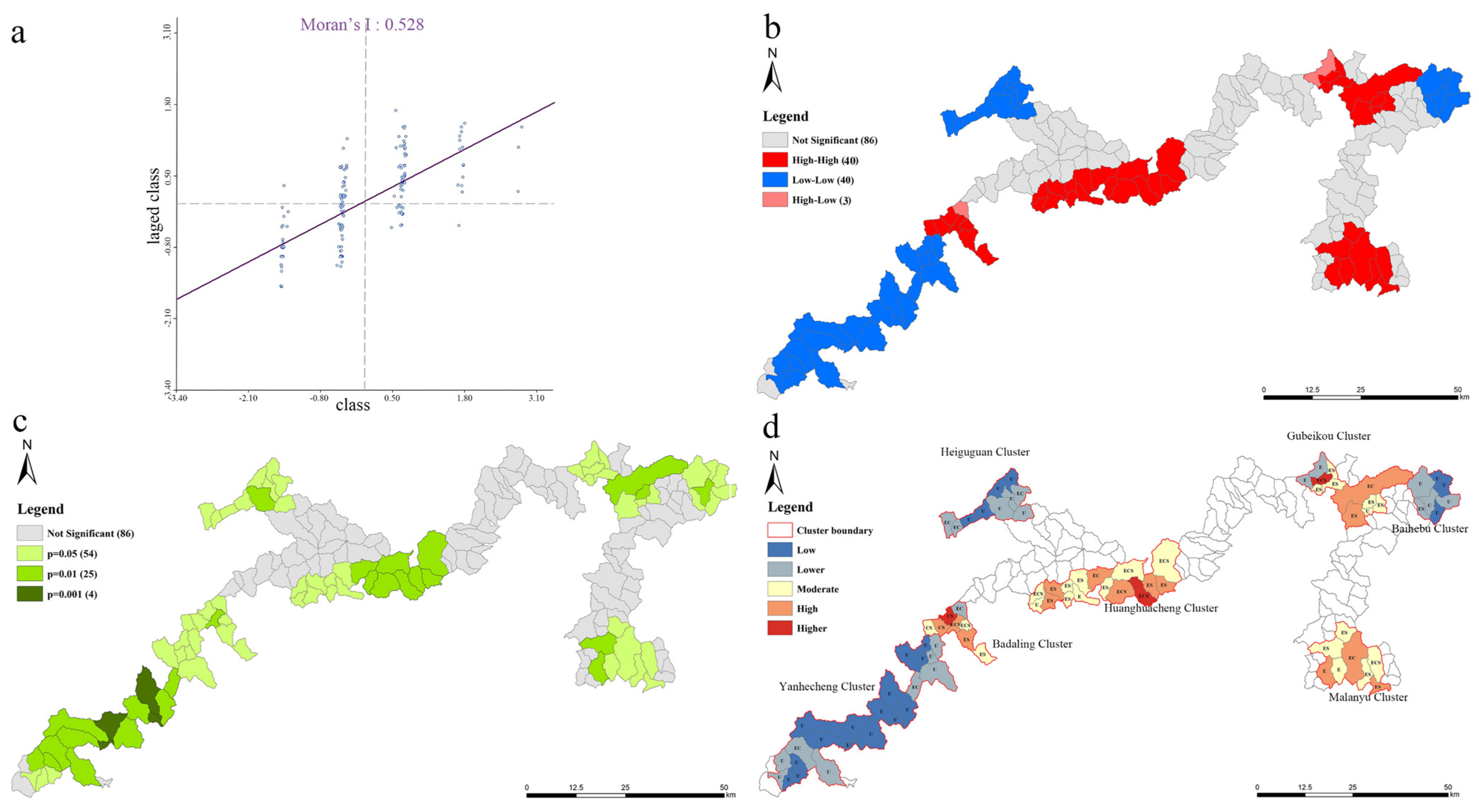
| Target | Criteria | Weight | Indicators | Index Weight () |
|---|---|---|---|---|
| Assessment index of sustainable development suitability (A) | Ecological suitability (B1) | 0.2913 | Vegetation coverage (C1) | 0.0812 |
| Landscape dominance (C2) | 0.0391 | |||
| Distance from the river (C3) | 0.0492 | |||
| Elevation (C4) | 0.0274 | |||
| Slope (C5) | 0.0518 | |||
| Cultural suitability (B2) | 0.3475 | Heritage distribution density (C6) | 0.1091 | |
| Mixing degree of heritage sites (C7) | 0.0299 | |||
| Grade of tourist attractions (C8) | 0.1084 | |||
| Tourist attractions density (C9) | 0.0704 | |||
| Population density (C10) | 0.1186 | |||
| Socio-economic suitability (B3) | 0.3611 | Road network density (C11) | 0.0462 | |
| Mixing degree of interest points (C12) | 0.0726 | |||
| Distance from main residential areas (C13) | 0.0354 | |||
| Infrastructure resource density (C14) | 0.0979 | |||
| Service facility resource density (C15) | 0.0664 |
| Very Low | Low | Moderate | High | Very High | |
|---|---|---|---|---|---|
| Class | 1 | 2 | 3 | 4 | 5 |
| Vegetation coverage (%) | 0–0.18 | 0.18–0.47 | 0.47–0.70 | 0.7–0.90 | 0.90–1.0 |
| Landscape dominance | <2.17 | 2.17–3.11 | 3.11–3.63 | 3.63–3.87 | >3.87 |
| Distance from the river (m) | >1200 | 800–1200 | 500–800 | 300–500 | 0–300 |
| Elevation (m) | >1690 | 1280–1690 | 880–1280 | 480–880 | 80–480 |
| Slope (°) | 12.5–22.5 | 9.0–12.5 | 6.0–9.0 | 3.5–6.0 | 0–3.5 |
| Heritage distribution density (PCs) | 0–6 | 7–14 | 15–23 | 24–35 | >35 |
| Mixing degree of heritage sites | 0–0.14 | 0.14–0.47 | 0.47–0.70 | 0.70–0.90 | 0.90–1.0 |
| Grade of tourist attractions | 0–2 | 2–4 | 4–6 | 6–8 | 8–10 |
| Tourist attractions density | <0.12 | 0.12–0.60 | 0.60–1.5 | 1.5–2.5 | 8–10 |
| Population density (person/km2) | <48 | 48–107 | 107–195 | 195–420 | >420 |
| Road network density (km/km2) | <0.16 | 0.16–0.48 | 0.48–0.8 | 0.8–1.4 | >1.4 |
| Mixing degree of interest points | <0.43 | 0.43–0.86 | 0.86–1.3 | 1.3–1.73 | >1.73 |
| Distance from main residential areas (m) | >4000 | 3000–4000 | 2000–3000 | 1000–2000 | <1000 |
| Infrastructure resource density | <0.25 | 0.25–0.65 | 0.65–1.14 | 1.14–1.65 | >1.65 |
| Service facility resource density | <0.07 | 0.07–0.26 | 0.26–0.55 | 0.55–0.96 | >0.96 |
Disclaimer/Publisher’s Note: The statements, opinions and data contained in all publications are solely those of the individual author(s) and contributor(s) and not of MDPI and/or the editor(s). MDPI and/or the editor(s) disclaim responsibility for any injury to people or property resulting from any ideas, methods, instructions or products referred to in the content. |
© 2023 by the authors. Licensee MDPI, Basel, Switzerland. This article is an open access article distributed under the terms and conditions of the Creative Commons Attribution (CC BY) license (https://creativecommons.org/licenses/by/4.0/).
Share and Cite
He, D.; Hu, J.; Zhang, J. Assessment of Sustainable Development Suitability in Linear Cultural Heritage—A Case of Beijing Great Wall Cultural Belt. Land 2023, 12, 1761. https://doi.org/10.3390/land12091761
He D, Hu J, Zhang J. Assessment of Sustainable Development Suitability in Linear Cultural Heritage—A Case of Beijing Great Wall Cultural Belt. Land. 2023; 12(9):1761. https://doi.org/10.3390/land12091761
Chicago/Turabian StyleHe, Ding, Jingchong Hu, and Jie Zhang. 2023. "Assessment of Sustainable Development Suitability in Linear Cultural Heritage—A Case of Beijing Great Wall Cultural Belt" Land 12, no. 9: 1761. https://doi.org/10.3390/land12091761
APA StyleHe, D., Hu, J., & Zhang, J. (2023). Assessment of Sustainable Development Suitability in Linear Cultural Heritage—A Case of Beijing Great Wall Cultural Belt. Land, 12(9), 1761. https://doi.org/10.3390/land12091761





